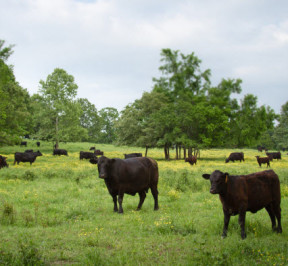Home Page › Halal Meat › BSE and Grass-Fed Beef

Jan 28
BSE and Grass-Fed Beef
The USDA announced on Tuesday the confirmation of another case of “mad cow” disease, the 4th to be found in the United States. This current case was in a dairy cow located in central California. Again, the consumer wonders about the safety of our food and should we be worried?
“Mad Cow” disease is bovine spongiform encephalopathy (BSE). A fatal neurodegenerative disease in cattle that causes a spongy degeneration in the brain and spinal cord. It can be transmitted to humans and is known as new variant Creutzfeldt–Jakob disease. Transmission to humans is felt to occur with the consumption of the brain, spinal cord or digestive tract of infected carcasses. At the height of the epizootic about half a million cattle (UK) had already entered the food chain before controls were put in place. Worldwide, 210 people died from exposure to the prion causing the disease which has a very long incubation period. This sent shock waves through the beef world especially when it was discussed on the Oprah Winfrey show. The bottom fell out of the beef market overnight as consumers had a panic. Last year there were 29 cases of BSE in cattle worldwide which represents a 99% decrease since the peak in 1992.
Investigation into BSE showed that the cattle contracted the disease from feed containing the remains of meat and bone meal from other animals (cattle and sheep). Cattle are of course herbivores and not intended to eat feed containing mammalian parts. Being strong advocates for a forage diet (biologically appropriate) or at least a vegetarian diet, I have a strong opinion you just should not mess with the way things ought to be. The BSE scare boosted the grassfed industry since we finish our cattle on forage with no contaminated feed.
The US has in place regulations that are aimed at preventing BSE. First, is the feed ban. In 1997, regulations prohibited the feeding of mammalian byproducts to ruminants were inacted. However, cattle can still be fed some animal by-products such as cow blood; poultry litter (fecal matter and feathers). The regulation to control this has been proposed but is yet to be implemented. Second, SRM are not allowed to enter the food chain and must be appropriately handled. Brain, spinal cord, trigeminal ganglia, intestines, eyes and tonsils from cows are classified as Specified Risk Material (SRM). These tissues harbor the prion.
According to the USDA;
“The United States has had longstanding interlocking safeguards to protect human and animal health against BSE. For public health, these measures include the USDA ban on specified risk materials, or SRMs, from the food supply. SRMs are parts of the animal that are most likely to contain the BSE agent if it is present in an animal. USDA also bans all nonambulatory (sometimes called “downer”) cattle from entering the human food chain. For animal health, the Food and Drug Administration (FDA) ban on ruminant material in cattle feed prevents the spread of the disease in the cattle herd.
In the official USDA guide it is stated that transmission occurs from the aberrant diet fed to cattle. Today, some researchers believe that there is a rare atypical form that spontaneously mutates and yet they can’t rule out feed transmission. It has been reported that this current case in California may be the mutant type. If this were the typical BSE then it would represent a significant failure in the effectiveness of the regulations aimed at controlling the disease. This would be unaccepatable both from a political and from an industrial standpoint.
In saying that, I remain a bit skeptical that since feed is the common means of transmission that this might indeed represent a failure in the feed ban. Hopefully, the further investigation and research will tell the truth.
Maybe this recent case was not caused by feed issues. Are grass-fed cows still safer?
Where I used to say that grass-fed beef carried absolutely no chance of BSE I concede a rare mutated prion can occur but that is still an unknown.
I also find it of interest to note that the major grass-fed countries such as Argentina, Australia and New Zealand have never reported a case of BSE. For me and my family I still choose pastured raised grass-fed beef.





